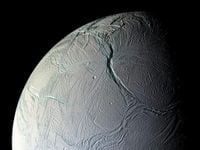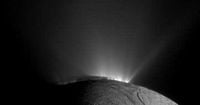Saturn’s moon Enceladus, a small, icy world orbiting far from the warmth of the Sun, has once again captured the scientific spotlight. In a breakthrough published in Nature Astronomy on October 1, 2025, researchers revealed that NASA’s Cassini spacecraft detected a remarkable diversity of complex organic molecules erupting from Enceladus’s frozen crust. This fresh analysis, led by astrobiologist Nozair Khawaja of the University of Stuttgart, has propelled Enceladus even higher on the list of places in our solar system where life might exist.
For years, Enceladus has intrigued scientists with its dramatic geysers—plumes of water ice and vapor blasting into space through fractures near its south pole. These geysers, first observed in detail by Cassini, hinted at a hidden ocean beneath the moon’s gleaming surface. But until now, the full chemical richness of those plumes remained a mystery.
The new study took a different approach from previous research. Instead of focusing on older, space-weathered grains floating in Saturn’s E ring, Khawaja’s team zeroed in on freshly ejected ice grains—particles that had just burst from the moon’s interior and had yet to be altered by the harsh environment of space. According to Anadolu Agency, this method provided “compositional insights into ice grains immediately after ejection and ensures that the compounds detected arise from the Enceladean subsurface rather than space weathering in Saturn’s E ring.”
What did they find? Using advanced data analysis and laboratory spectral comparisons, the researchers uncovered a suite of organic compounds never before seen in this kind of extraterrestrial environment. The detected molecules included aromatics, aldehydes, esters, ethers, and alkenes, as well as nitrogen- and oxygen-bearing compounds. Some of these, such as benzenelike structures with oxygen and nitrogen side chains, are particularly intriguing because they act as precursors to important biological molecules. As Khawaja told Nature Astronomy, “there are many possible pathways from the organic molecules we found in the Cassini data to potentially biologically relevant compounds.”
But how did Cassini, a spacecraft launched in 1997 and not even designed to search for life, make such a discovery? The answer lies in a key flyby in October 2008, when Cassini hurtled through a newly erupted plume at nearly 18 kilometers per second (17.7 km/s, to be precise). At that speed, the ice grains slammed into the spacecraft’s Cosmic Dust Analyzer (CDA), shattering into fragments and revealing their chemical secrets. The CDA, intended to study dust and ice particles, ended up providing a window into Enceladus’s hidden ocean.
Deciphering the data was no easy feat. As Khawaja explained, “At lower impact speeds, the ice shatters, and the signal from clusters of water molecules can hide the signal from certain organic molecules. But when the ice grains hit CDA fast, water molecules don’t cluster, and we have a chance to see these previously hidden signals.” By comparing the impact patterns to laboratory experiments and vast chemical databases, the team was able to tease out faint signals that had previously been buried beneath noise.
The result? The identification of a host of organic molecules, including benzenelike compounds that may serve as the building blocks for pyrimidines (the base molecules in DNA) and lipids (essential for cell membranes). These discoveries suggest that Enceladus’s subsurface ocean is not only salty and dynamic but also chemically diverse, with pathways strikingly similar to the hydrothermal reactions found at Earth’s ocean floor.
On our own planet, hydrothermal vents support entire ecosystems that thrive without sunlight, relying instead on chemical energy from heat and minerals. Scientists have long speculated that such environments could be the cradle of life. The evidence from Enceladus now points to a similar scenario unfolding beneath its icy shell. As Anadolu Agency reported, “the results indicate that Enceladus’s subsurface ocean is chemically diverse, with pathways similar to hydrothermal reactions found on Earth’s ocean floor.”
Enceladus itself is a relatively tiny moon, just 500 kilometers (310 miles) across, but it boasts a global salty ocean beneath a crust of bright ice. The constant gravitational tug from Saturn and neighboring moons generates internal friction, preventing the ocean from freezing solid. This same process likely powers the hydrothermal activity suspected on the ocean floor, fueling the geysers that serve as natural sample-return missions for any passing spacecraft.
Perhaps most tantalizing for astrobiologists is the fact that five of the six essential elements for life as we know it—carbon, hydrogen, nitrogen, oxygen, and phosphorus, collectively known as CHNOPS—have now been confirmed in Enceladus’s plumes. The only missing ingredient is sulfur. Previous Cassini flybys had already identified salts, methane, and phosphates in the ejected material, but the new findings add a wealth of organic complexity. As Khawaja put it, “We don’t have a clue about any actual biological relevance yet,” but the building blocks are undeniably there.
Of course, none of this is direct evidence for life. The molecules detected could have formed through abiotic processes—chemical reactions unrelated to biology. Yet the parallels to Earth’s hydrothermal systems, coupled with the sheer diversity of organics, make Enceladus a compelling target for future exploration. “While the detected molecules are not evidence of life, they point to a chemically rich environment that could support biological processes,” Nature Astronomy noted.
So, what’s next for the search for life on Enceladus? Scientists are already dreaming up new missions. Some advocate for a lander to touch down on the moon’s surface and analyze the ice up close. Others, like NASA astrobiologist Kevin Hand, suggest that more fly-through sampling—making use of the moon’s “free samples”—could yield further insights without the need to land. Either way, the case for returning to Enceladus has never been stronger.
As the scientific community digests these latest findings, one thing is clear: Enceladus is handing us clues about the nature of its hidden ocean and, perhaps, about the broader question of life beyond Earth. The moon’s geysers have become cosmic messengers, carrying secrets from a world that, while tiny and remote, may hold answers to some of humanity’s oldest questions. With each new discovery, the icy plumes of Enceladus beckon us to look deeper, to wonder, and to explore.





